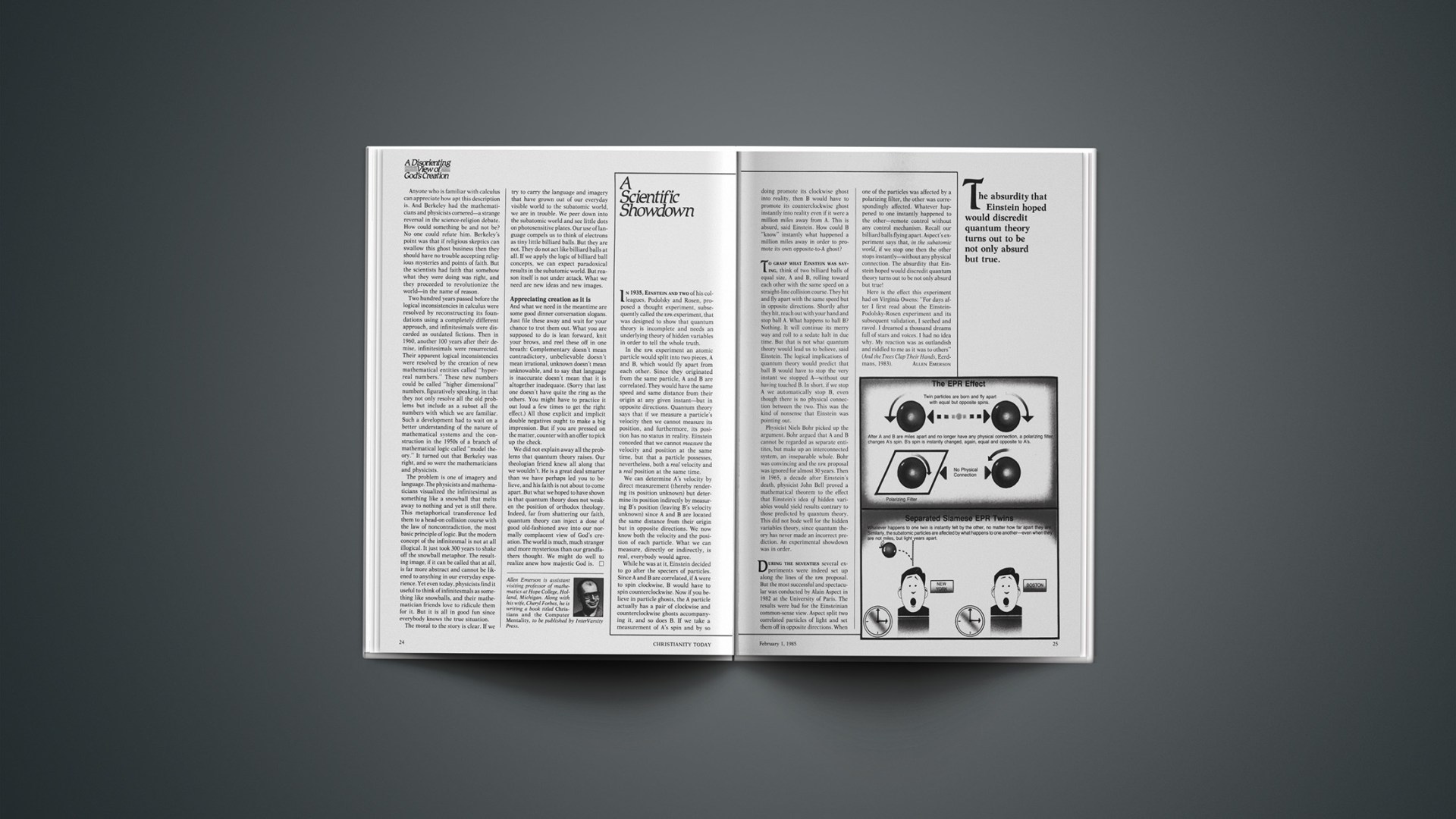In 1935, Einstein and two of his colleagues, Podolsky and Rosen, proposed a thought experiment, subsequently called the EPR experiment, that was designed to show that quantum theory is incomplete and needs an underlying theory of hidden variables in order to tell the whole truth.
In the EPR experiment an atomic particle would split into two pieces, A and B, which would fly apart from each other. Since they originated from the same particle, A and B are correlated. They would have the same speed and same distance from their origin at any given instant—but in opposite directions. Quantum theory says that if we measure a particle’s velocity then we cannot measure its position, and furthermore, its position has no status in reality. Einstein conceded that we cannot measure the velocity and position at the same time, but that a particle possesses, nevertheless, both a real velocity and a real position at the same time.
We can determine A’s velocity by direct measurement (thereby rendering its position unknown) but determine its position indirectly by measuring B’s position (leaving B’s velocity unknown) since A and B are located the same distance from their origin but in opposite directions. We now know both the velocity and the position of each particle. What we can measure, directly or indirectly, is real, everybody would agree.
While he was at it, Einstein decided to go after the specters of particles. Since A and B are correlated, if A were to spin clockwise, B would have to spin counterclockwise. Now if you believe in particle ghosts, the A particle actually has a pair of clockwise and counterclockwise ghosts accompanying it, and so does B. If we take a measurement of A’s spin and by so doing promote its clockwise ghost into reality, then B would have to promote its counterclockwise ghost instantly into reality even if it were a million miles away from A. This is absurd, said Einstein. How could B “know” instantly what happened a million miles away in order to promote its own opposite-to-A ghost?
To grasp what Einstein was saying, think of two billiard balls of equal size, A and B, rolling toward each other with the same speed on a straight-line collision course. They hit and fly apart with the same speed but in opposite directions. Shortly after they hit, reach out with your hand and stop ball A. What happens to ball B? Nothing. It will continue its merry way and roll to a sedate halt in due time. But that is not what quantum theory would lead us to believe, said Einstein. The logical implications of quantum theory would predict that ball B would have to stop the very instant we stopped A—without our having touched B. In short, if we stop A we automatically stop B, even though there is no physical connection between the two. This was the kind of nonsense that Einstein was pointing out.
Physicist Niels Bohr picked up the argument. Bohr argued that A and B cannot be regarded as separate entitites, but make up an interconnected system, an inseparable whole. Bohr was convincing and the EPR proposal was ignored for almost 30 years. Then in 1965, a decade after Einstein’s death, physicist John Bell proved a mathematical theorem to the effect that Einstein’s idea of hidden variables would yield results contrary to those predicted by quantum theory. This did not bode well for the hidden variables theory, since quantum theory has never made an incorrect prediction. An experimental showdown was in order
During the seventies several experiments were indeed set up along the lines of the EPR proposal. But the most successful and spectacular was conducted by Alain Aspect in 1982 at the University of Paris. The results were bad for the Einsteinian common-sense view. Aspect split two correlated particles of light and set them off in opposite directions. When one of the particles was affected by a polarizing filter, the other was correspondingly affected. Whatever happened to one instantly happened to the other—remote control without any control mechanism. Recall our billiard balls flying apart. Aspect’s experiment says that, in the subatomic world, if we stop one then the other stops instantly—without any physical connection. The absurdity that Einstein hoped would discredit quantum theory turns out to be not only absurd but true!
Here is the effect this experiment had on Virginia Owens: “For days after I first read about the Einstein-Podolsky-Rosen experiment and its subsequent validation, I seethed and raved. I dreamed a thousand dreams full of stars and voices. I had no idea why. My reaction was as outlandish and riddled to me as it was to others” (And the Trees Clap Their Hands, Eerdmans, 1983).










